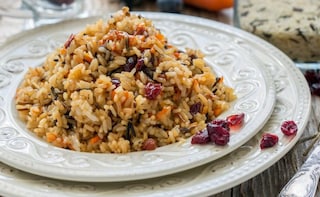One of my frequent bugbears is the interchangeable use of the terms "biryani", "pulao" and, well, "tehri" to a lesser extent. All are loosely used to describe just about any rice-with-spice dish with meats or veggies bunged in. And each time, someone I know and possibly hold dear uses the words "veg pulao" or "veg biryani", I mentally cringe! For years now, I have been (gently) trying to correct the usage, and so it is here once again-the distinction between the three, what really is a pilaf/pulao, how is it different from a biryani. What is a tehri, a term people have almost forgotten to use. And, well, first things first: why there is no such thing as "veg pulao" or "veg biryani"!
Rice & Its Varied Preparations
The pulao of Delhi evolved into the many biryanis of India, where higher levels of spices were added, including khus khus, copra and sesame in Hyderabad. The biryani was also created by layering the rice and meat (which could be pre-cooked or kachcha) and that sets it apart from the pulao. But it is also true that the pilaf/pulao is a much more subtly spiced dish than the biryani.If you know the histories of these dishes, you would of course understand why there are no real vegetarian pulaos and biryanis. The Afghan pulaos - Kabuli Pulao as it is called - use vegetables like carrots and dried fruit like raisins to offer contrasting flavours of sweet and saltiness. But these are in addition to meat. The main flavour of the pilaf/pulao and indeed the separation of its grains comes from stock made with meat.The tehri, on the other hand, is the vegetarian cousin of the pulao in the Subcontinent. A dish made using fresh seasonal vegetables and rice. But that is a separate story.
Disclaimer:The opinions expressed within this article are the personal opinions of the author. NDTV is not responsible for the accuracy, completeness, suitability, or validity of any information on this article. All information is provided on an as-is basis. The information, facts or opinions appearing in the article do not reflect the views of NDTV and NDTV does not assume any responsibility or liability for the same.
Rice & Its Varied Preparations
Advertisement
The pulao of Delhi evolved into the many biryanis of India, where higher levels of spices were added, including khus khus, copra and sesame in Hyderabad. The biryani was also created by layering the rice and meat (which could be pre-cooked or kachcha) and that sets it apart from the pulao. But it is also true that the pilaf/pulao is a much more subtly spiced dish than the biryani.
Advertisement
Disclaimer:The opinions expressed within this article are the personal opinions of the author. NDTV is not responsible for the accuracy, completeness, suitability, or validity of any information on this article. All information is provided on an as-is basis. The information, facts or opinions appearing in the article do not reflect the views of NDTV and NDTV does not assume any responsibility or liability for the same.
Advertisement
For the latest food news, health tips and recipes, like us on Facebook or follow us on Twitter and YouTube.
Advertisement
